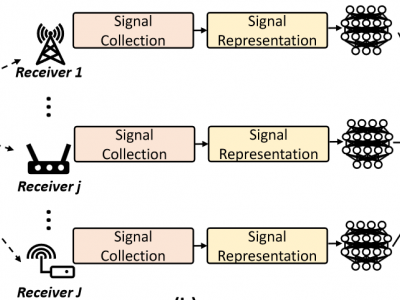LoRa
This dataset contains LoRa physical layer signals collected from 60 LoRa devices and six SDRs (PLUTO-SDR, USRP B200 mini, USRP B210, USRP N210, RTL-SDR). It is intended for use by researchers in the development of a federated RFFI system, whereby the signals collected from different receivers and locations can be employed for evaluation purposes.
More details can be found at https://github.com/gxhen/federatedRFFI
- Categories:
 962 Views
962 ViewsRadio frequency fingerprint identification (RFFI) is an emerging device authentication technique, which exploits the hardware characteristics of the RF front-end as device identifiers. The receiver hardware impairments interfere with the feature extraction of transmitter impairments, but their effect and mitigation have not been comprehensively studied. In this paper, we propose a receiver-agnostic RFFI system by employing adversarial training to learn the receiver-independent features.
- Categories:
 731 Views
731 Views
In situations when the precise position of a machine is unknown, localization becomes crucial. It is crucial to identify and ascertain the machine's position. This research focuses on improving the position prediction accuracy over long-range networks using a unique machine learning-based technique. In order to increase the prediction accuracy of the reference point position on the data collected using the fingerprinting approach using LoRa technology, this study suggested an ML-based algorithm.
- Categories:
 720 Views
720 Views
This project builds a length-versatile and noise-robust LoRa radio frequency fingerprint identification (RFFI) system. The LoRa signals are collected from 10 commercial-off-the-shelf LoRa devices, with the spreading factor (SF) set to 7, 8, 9, respectively. The packet preamble part and device labels are provided.
- Categories:
 1884 Views
1884 ViewsThis LoRa-RFFI project builds a LoRa radio frequency fingerprint identification (RFFI) system based on deep learning techniques. The RF signals are collected from 60 commercial-off-the-shelf LoRa devices. The packet preamble part and device labels are provided. The dataset consists of 19 sub-datasets and please refer to the README document for more detailed collection settings for all the sub-datasets.
- Categories:
 8890 Views
8890 Views
Demo script and data for infocom 2022 paper titled "Don’t Miss Weak Packets: Boosting LoRa Reception with Antenna Diversities"
- Categories:
 251 Views
251 ViewsFor the innovation challenge for unmanned aerial vehicle (UAV) communications, we propose to demonstrate a two-tier Low Power Wide Area Network (LP-WAN) based on UAV base stations suitable for dynamic deployment and reconfiguration in deep rural areas. The proposed UAV-based LP-WAN network augments the existing macro-cellular NB-IoT network (Tier 1) with either an additional layer of mobile NB-IoT base stations or an additionaly layer of mobile LoRa base stations (Tier2).
- Categories:
 448 Views
448 ViewsAs Science and technology evolve, the environment is getting affected daily. These cause major environmental issues like Global Warming, Ozone layer depletion, Natural resource depletion, etc. These are measured and regulated by local bodies. The data given by the local bodies are average values for a large area, those data might be inaccurate for a small sector or isolated zone. However, there are few techniques such as WSN (Wireless Sensor Networks), IoT (Internet of things) which measures and updates real-time data to a cloud server to overcome the trouble.
- Categories:
 1772 Views
1772 ViewsExtensive experimental measurement campaigns of more than 30,000 data points of end-to-end latency measurements for the following network architecture schemes is available:
- Unlicensed IoT (standalone LoRa)
- Cellular IoT (standalone LTE-M)
- Concatenated IoT (LoRa interfaced with LTE-M)
Download Data.zip to access all relevant files for the open data measurements.
Related Paper:
- Categories:
 2819 Views
2819 Views






